Introduction to Persistent Cough in Preschoolers
A persistent cough in preschool-aged children is a common concern that often brings parents and caregivers to seek medical advice. While many coughs are due to viral infections and resolve on their own, others may indicate underlying conditions requiring thorough evaluation. This article explores causes, diagnostic strategies, management, and guidance for parents on evaluating persistent coughs in young children to ensure timely and effective care.
Causes and Classification of Persistent Cough in Preschoolers
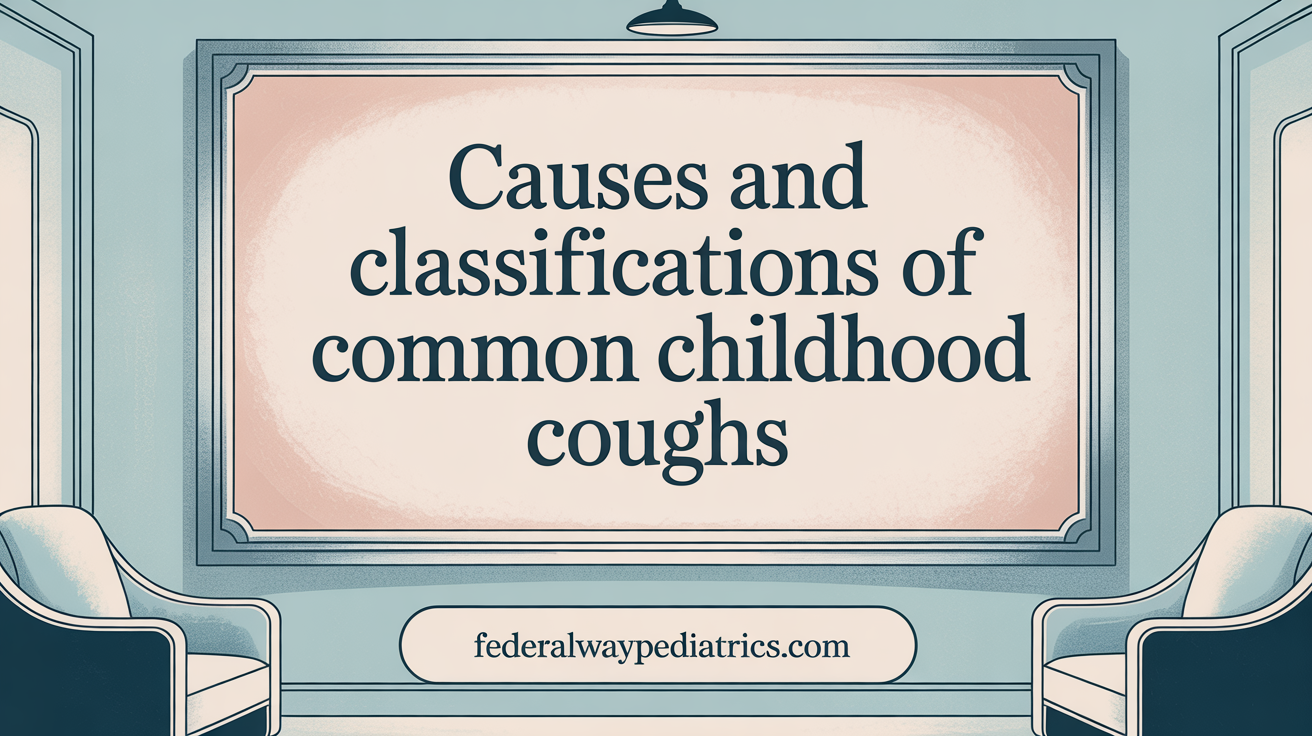
What is a chronic cough, and what are the duration thresholds?
A cough is considered chronic when it lasts more than four weeks in children. This duration helps distinguish between typical viral infections, which usually resolve within a week or two, and more persistent conditions that require further investigation.
Common causes of persistent cough in young children
The most frequent reasons include asthma, protracted bacterial bronchitis (PBB), upper airway cough syndrome caused by allergies or sinusitis, and gastroesophageal reflux disease (GERD). Other less common causes are congenital abnormalities, immune deficiencies, cystic fibrosis, and inhaled foreign bodies.
How do etiologies differ between acute and chronic cough?
Acute coughs (<4 weeks) are typically caused by viral respiratory infections, which are self-limited. In contrast, chronic coughs (>4 weeks) may stem from conditions like asthma, persistent bacterial infections, or structural abnormalities. Recognizing these differences guides clinicians in choosing appropriate diagnostics and treatments.
Specific conditions causing persistent cough
- Viral infections: Usually self-resolving but can occasionally contribute to longer coughs if complications develop.
- Protracted bacterial bronchitis: Often caused by bacteria such as Haemophilus influenzae or Streptococcus pneumonia, resulting in thick mucus and wet cough.
- Asthma and cough variant asthma: Characterized by a dry, persistent cough, which worsens at night or with activity.
- Pertussis (whooping cough): Noted for uncontrollable coughing episodes with a distinctive ‘whoop’ sound.
- Foreign body aspiration: Causes sudden onset of cough; usually dry but can be wet if infection occurs.
- GERD: Worsening in upright positions or after feeding.
- Congenital anomalies: Including airway malformations, may cause persistent cough, especially in infants.
Wet versus dry coughs: distinguishing features
Wet coughs produce mucus or phlegm and often suggest bacterial infection, PBB, or sinusitis. Dry coughs are typically caused by airway irritation, asthma, or allergies. Observing cough character helps narrow the differential diagnosis.
Red flags indicating serious illness
Signs like difficulty breathing, bluish lips, severe cough, high fever, or persistent choking require urgent evaluation. Such features suggest conditions like severe infection, foreign body, or congenital airway abnormalities.
Understanding the various causes of persistent cough and their distinguishing features allows healthcare providers to tailor assessments, incorporate appropriate testing such as chest X-ray or lung function testing, and initiate targeted treatments to improve children’s health outcomes.
Clinical Evaluation and Diagnostic Approaches
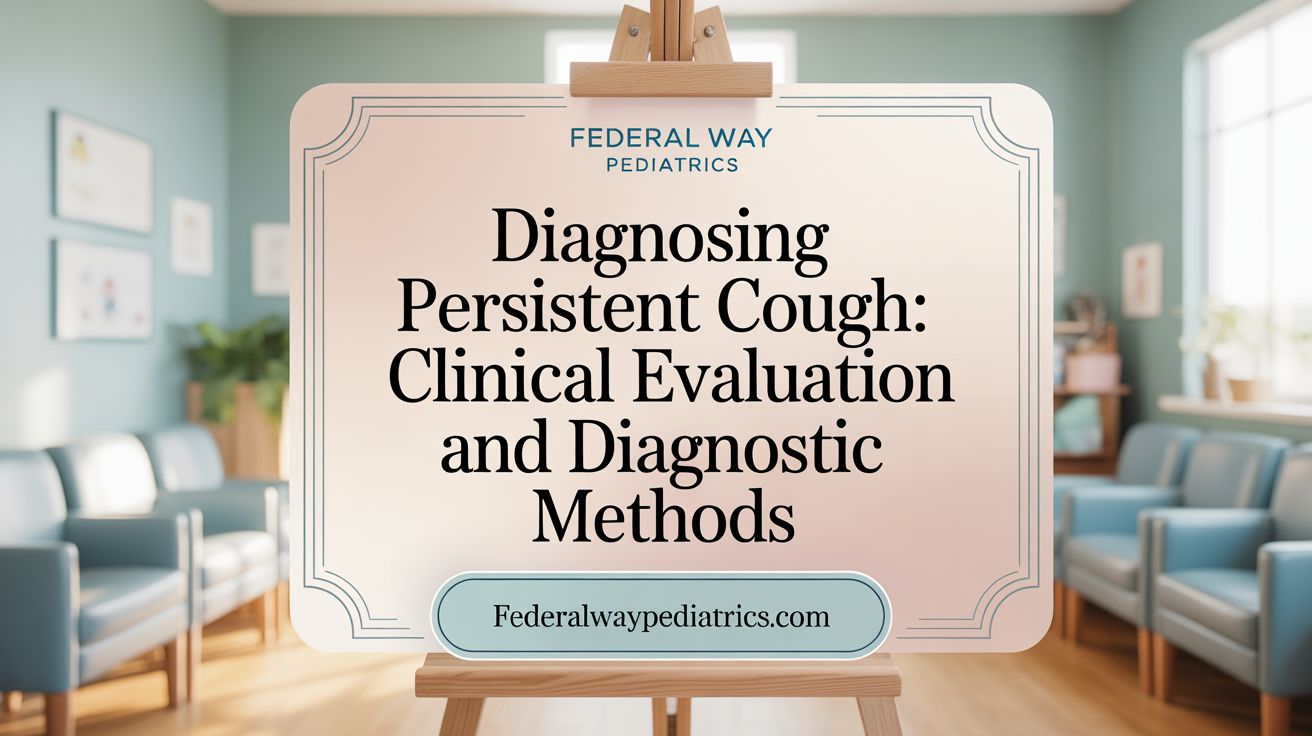
What are the key steps in assessing a child with cough or difficulty in breathing?
Assessing a child presenting with cough or breathing difficulty involves a systematic approach. First, clinicians must look for any signs of serious illness, known as red flags, such as difficulty swallowing, drooling, cyanosis (blue lips or fingertips), or marked respiratory distress requiring urgent medical intervention. Identifying these signs prompts immediate action.
Next, a detailed medical history is crucial. This includes documenting the cough's duration and characteristics—whether it is dry or wet, its pattern (intermittent or persistent), and any associated symptoms like fever, wheezing, chest pain, or fatigue. Exposure history, such as contact with infectious individuals or exposure to environmental irritants like smoke, is also valuable.
Physical examination follows, focusing on respiratory rate and pattern. Clinicians observe for signs of labored breathing, chest retractions, or use of accessory muscles. Listening to breath sounds helps identify abnormal findings like wheezing, stridor, or crackles, which point toward specific diagnoses. Overall condition also needs assessment, including hydration and mental status, guiding immediate management or the need for emergency care.
This structured evaluation ensures that urgent cases are promptly identified and that further diagnostic testing is appropriately targeted.
What are common diagnostic approaches for evaluating a persistent cough in children?
When dealing with ongoing coughs in children, a thorough diagnostic process is essential. It begins with a comprehensive history and physical examination aimed at exploring potential causes like infections, allergies, or structural abnormalities.
Imaging studies are a cornerstone of evaluation. A chest X-ray can reveal lung or cardiac abnormalities, signs of infections like pneumonia, or features of bronchiectasis. In some cases, more detailed imaging such as CT scans provides better visualization of lung structures.
Laboratory tests supplement imaging. Blood tests can detect infection or allergic responses, while throat or nasal swabs identify specific pathogens like bacteria, viruses, or atypical organisms.
For persistent or recurrent symptoms, pulmonary function tests, including spirometry, help assess airway reactivity, particularly in suspected asthma. The methacholine challenge may further confirm airway hyperresponsiveness.
In cases where the cause remains unclear, procedures like bronchoscopy allow direct visualization of the airways and aid in detecting foreign bodies, structural anomalies, or mucus plugging.
Serologic tests and pH monitoring can also be employed if gastroesophageal reflux disease (GERD) or other systemic causes are suspected.
Collectively, these investigations help delineate the exact etiology of the cough, guiding effective treatment.
Management and Treatment Options for Persistent Cough
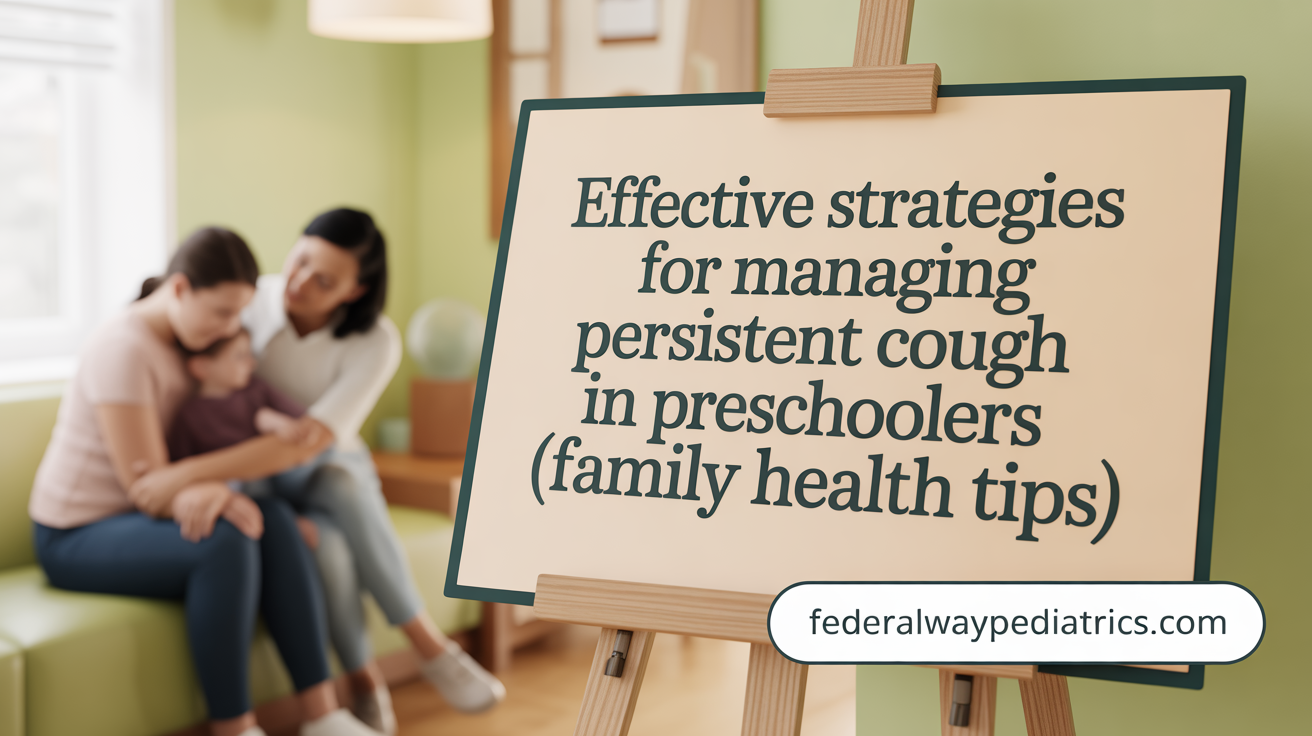
What are effective management and treatment options for a persistent cough in preschool-aged children?
Treating a persistent cough in young children starts with a thorough clinical assessment to determine the underlying cause. This involves taking a detailed medical history and performing a physical examination focused on respiratory signs and symptoms.
Supportive care measures are fundamental. These include maintaining good hydration, using saline nasal drops or sprays to clear nasal congestion, and employing humidifiers to keep the air moist. Avoiding environmental irritants such as cigarette smoke, strong fumes, and dust can help reduce airway inflammation and improve comfort.
When the diagnosis is clear, targeted treatments are employed. For example, antibiotics are indicated in cases of bacterial infections like protracted bacterial bronchitis, while inhaled corticosteroids can be beneficial in managing asthma or cough-variant asthma.
Most over-the-counter cough medicines or suppressants are not recommended for children under four years of age, as they offer limited benefit and pose risks such as adverse reactions.
Effective management emphasizes addressing the underlying cause rather than solely alleviating symptoms. This approach enhances the chance of resolving the cough permanently.
If the cough persists longer than four weeks, worsens, or is associated with alarming symptoms—such as difficulty breathing, chest pain, or signs of systemic illness—referral to a healthcare professional or specialist is advised. Pulmonologists or pediatric respiratory specialists can conduct further investigations, including lung function tests or imaging, to identify less common causes.
Education and follow-up play vital roles. Parents should be advised on monitoring symptoms, avoiding triggers, and when to seek urgent care. Regular review ensures that treatment remains appropriate and effective.
In summary, effective management involves a combination of supportive care, targeted therapy based on the specific diagnosis, cautious use of medications, and ongoing monitoring to ensure full recovery of the child.
Guidance for Parents and Caregivers: Monitoring and When to Seek Help
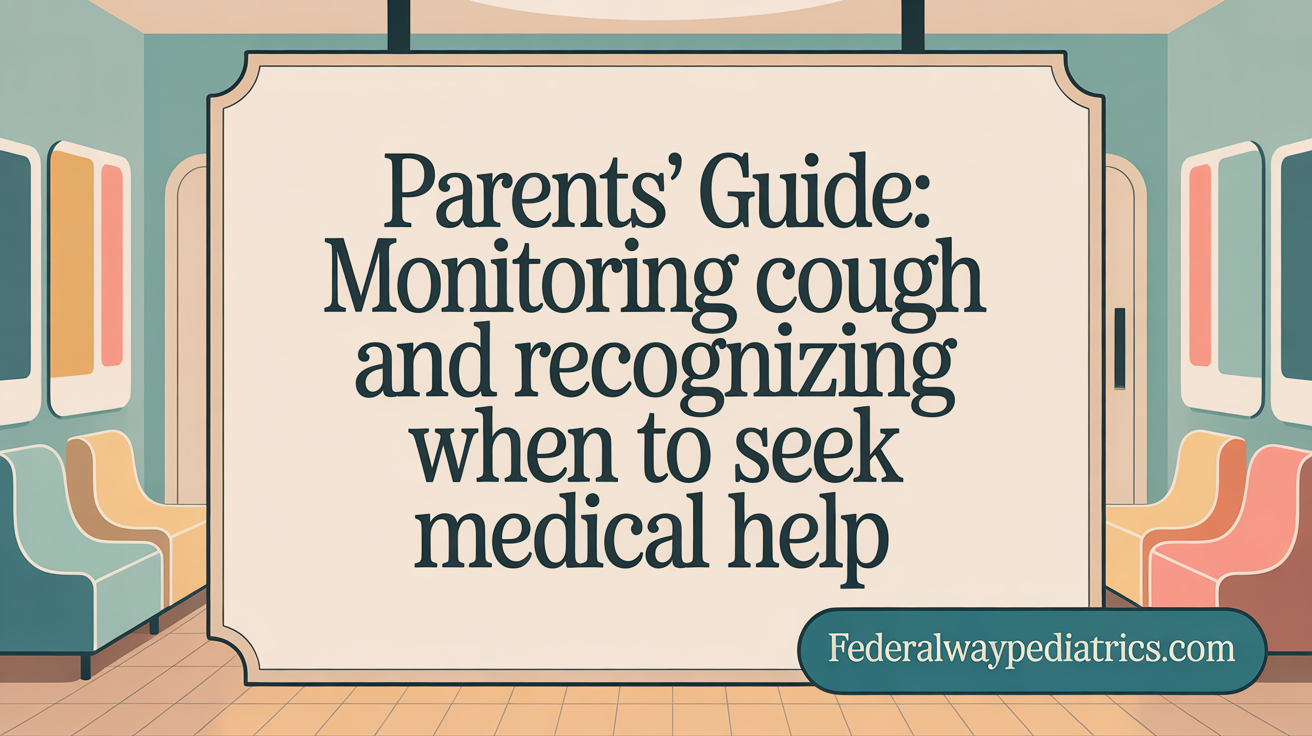 Monitoring a child's cough carefully is essential for parents and caregivers. Pay attention to how long the cough lasts, its pattern—whether dry or wet—and if it occurs more at night. Notice any additional symptoms such as fever, difficulty breathing, or allergy signs like sneezing and itchy eyes. Keep track of whether the cough is persistent, worsening, or associated with other concerning features.
Monitoring a child's cough carefully is essential for parents and caregivers. Pay attention to how long the cough lasts, its pattern—whether dry or wet—and if it occurs more at night. Notice any additional symptoms such as fever, difficulty breathing, or allergy signs like sneezing and itchy eyes. Keep track of whether the cough is persistent, worsening, or associated with other concerning features.
Most coughs in children resolve within a week or two, but if a cough lasts more than four weeks, it warrants medical evaluation. Look for red flags such as rapid breathing, blue lips, persistent high fever, or signs of respiratory distress like wheezing or stridor. Emergency signs like difficulty swallowing, drooling, or a stiff neck require urgent care immediately.
It's important to avoid giving young children over-the-counter cough medicines without healthcare guidance. Support your child by ensuring they stay hydrated and rest. If in doubt or if symptoms worsen, consult a healthcare professional.
Healthcare providers will typically evaluate persistent coughs through a thorough history, physical exam, and diagnostic tests like chest X-ray or spirometry to determine the cause. Early medical consultation helps address possible conditions such as asthma, sinusitis, or respiratory infections, ensuring appropriate treatment and peace of mind for parents and caregivers.
Epidemiology and Research Insights on Persistent Cough in Children
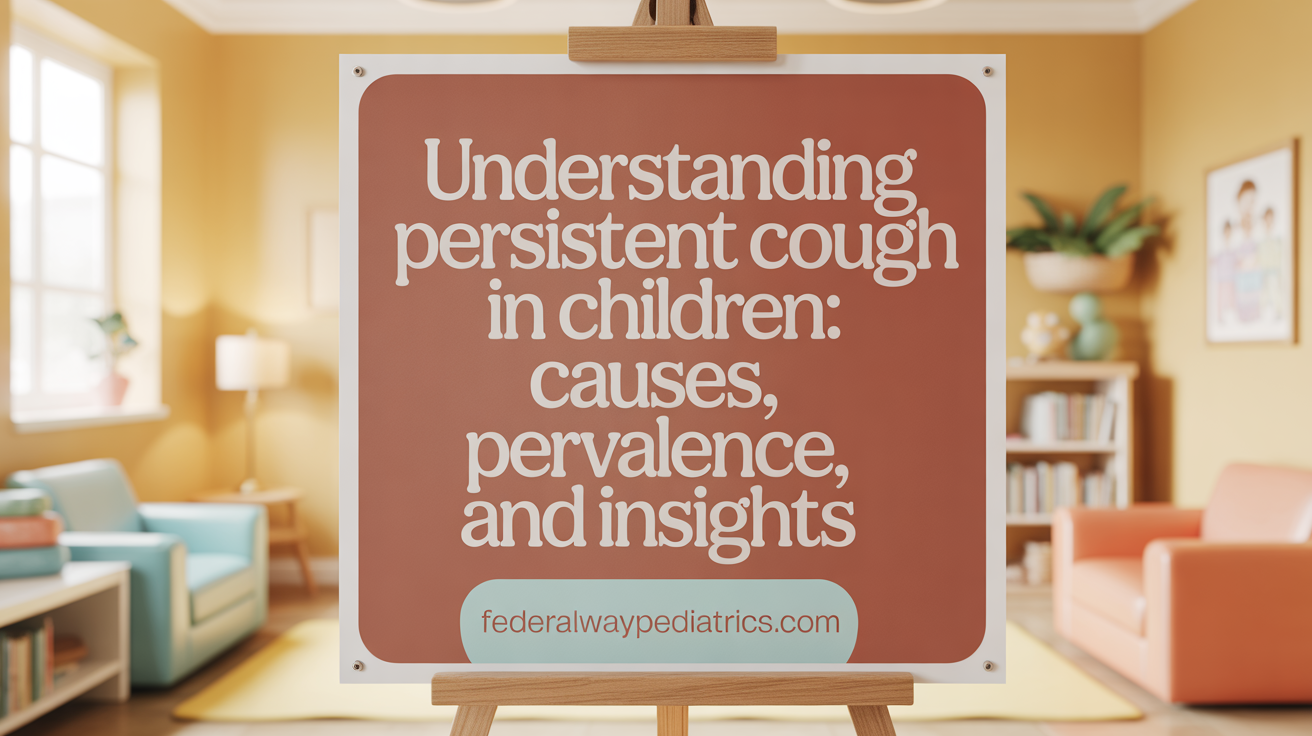
How common is persistent cough in children and what causes it?
Research indicates that persistent or recurrent upper respiratory infections (URIs) are quite prevalent among children, particularly those in daycare settings. Studies show that most of these coughs last between 7 to 9 days, although some can persist for more than 15 days. The most frequent cause of chronic cough in this age group is protracted bacterial bronchitis (PBB), where bacterial infection leads to increased mucus production in the bronchi. Common pathogens involved include Haemophilus influenza and Streptococcus pneumonia.
Despite the widespread success of vaccination programs, Bordetella pertussis (whooping cough) remains an important concern. It can cause uncontrollable and prolonged cough episodes, sometimes with characteristic 'whoop' sounds, even in vaccinated children, highlighting the importance of ongoing surveillance and booster immunizations.
What have studies and guidelines revealed about managing persistent cough?
A notable study involving 108 children aged 6 to 14 years used the 2006 American College of Chest Physicians (ACCP) guidelines for diagnosing chronic cough. It found that most cases could be effectively categorized into conditions like asthma (25%), protracted bronchitis (23.4%), and upper airway cough syndrome (20.3%). Chest radiographs and pulmonary function tests provided crucial diagnostic information.
Management approaches based on these studies emphasize the importance of a thorough history, physical exam, and targeted testing. Such evidence-based strategies, including the use of algorithms from established guidelines, have proven effective even in resource-limited settings.
Are causes of cough different by age?
Yes, the causes of cough vary significantly with age. In very young children, foreign body aspiration and congenital anomalies stand out, whereas asthma and sinusitis are more common in school-aged children. The same research also highlights that certain causes like gastroesophageal reflux are less common but still relevant. Notably, the likelihood of specific causes like cystic fibrosis or immune deficiencies increases with the presence of recurrent infections or associated systemic symptoms.
How effective are current guidelines in clinical practice?
Guidelines such as those from the ACCP have demonstrated high applicability in diverse settings. They facilitate systematic evaluation, helping clinicians distinguish between benign viral-related coughs and those requiring further investigation. Implementation of these guidelines has improved diagnostic accuracy, ensuring children receive appropriate treatment without unnecessary use of antibiotics or over-the-counter remedies.
What about emerging infectious threats?
Pertussis remains a significant concern, with cases reported even in vaccinated children. Its hallmark is a prolonged cough that may recur after initial resolution, underscoring the need for booster vaccines and vigilant clinical diagnosis, especially in outbreaks.
What are the long-term outcomes for children with persistent cough?
Most children, when correctly diagnosed and treated for underlying causes, recover fully within weeks. Early intervention in conditions like asthma, sinusitis, or bacterial bronchitis minimizes the risk of complications such as otitis media or sinusitis. Non-infectious causes, if identified early, generally improve with tailored therapy, illustrating the importance of ongoing research and guideline development to optimize pediatric respiratory health.
Preventive Measures and Long-term Considerations
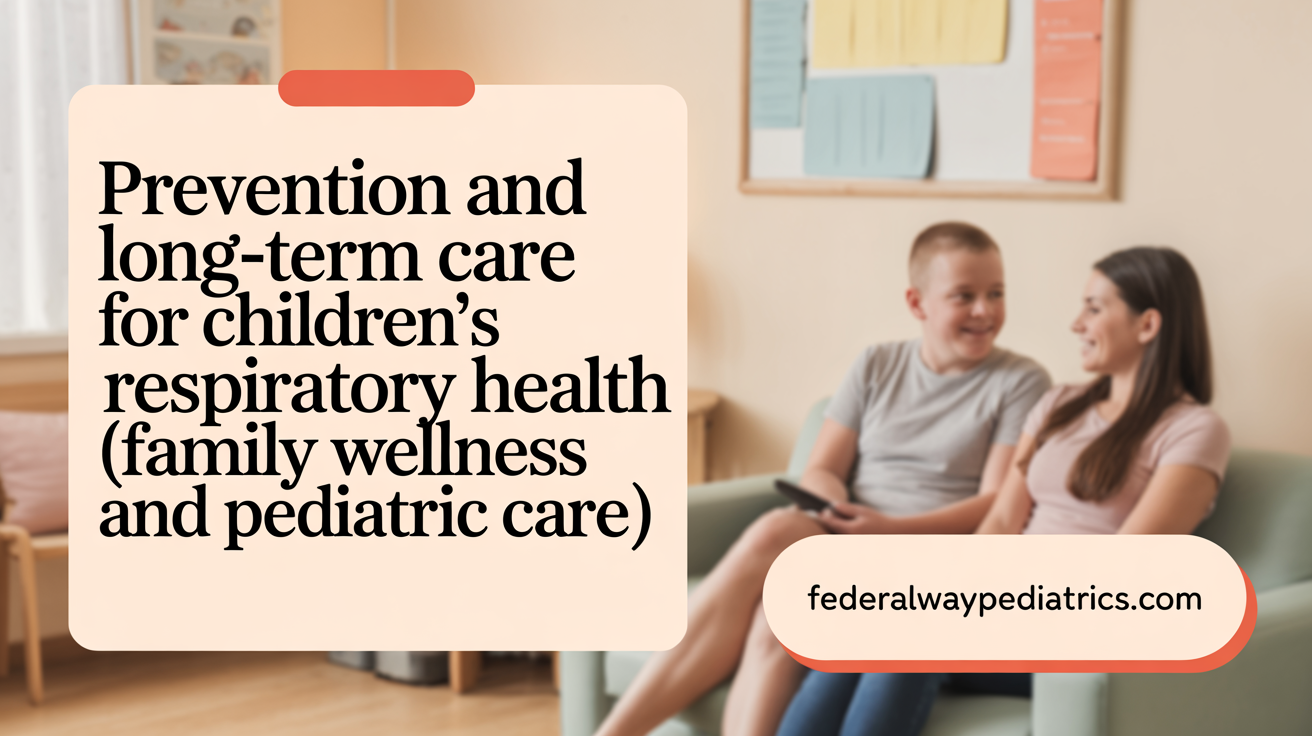
How can environmental factors be managed to prevent chronic cough in children?
Avoiding environmental irritants such as second-hand smoke, indoor and outdoor pollutants, and allergens is vital. Exposure to tobacco smoke and pollution can worsen airway inflammation and increase the risk of recurrent URIs and prolonged coughing.
Parents should ensure living spaces are well-ventilated, avoid cigarette smoke around children, and minimize exposure to strong fumes or chemicals.
Why are immunizations important in preventing long-term respiratory issues?
Maintaining up-to-date immunizations, particularly against pertussis (whooping cough), can significantly reduce the incidence of bacterial infections causing prolonged coughs. These vaccines protect children from preventable illnesses that could cause persistent respiratory symptoms.
How does good hygiene contribute to reducing recurrent URIs?
Practicing regular handwashing, discouraging sharing of personal items, and managing exposure to infected individuals help limit the spread of viruses and bacteria, reducing the frequency of URIs that may develop into chronic coughs.
What role does nasal irrigation and allergen control play?
Nasal irrigation with saline solutions can help clear nasal passages and mucus build-up, especially in children with allergies or sinusitis. Controlling allergens such as dust mites, pet dander, and mold can lessen airway irritation and prevent recurrent cough episodes.
How should recurrent URIs and complications be addressed?
Persistent or recurrent URIs warrant medical evaluation to prevent complications like sinusitis or otitis media. Early treatment and management of underlying illnesses can limit their progression and reduce long-term cough issues.
When should parents consider specialist referral?
Children with a chronic cough lasting more than four weeks, or those with signs of serious illness such as difficulty breathing, cyanosis, or failure to thrive, should be referred to a pediatric pulmonologist or other specialists. Comprehensive evaluation including detailed history, physical examination, imaging, and lung function tests may be needed for accurate diagnosis and targeted treatment.
Summary and Key Takeaways
Persistent cough in preschoolers is a multifaceted symptom with numerous potential causes, ranging from common viral infections to serious underlying conditions. A methodical approach involving careful history-taking, thorough physical examination, and appropriate diagnostics is essential for accurate diagnosis and effective treatment. Parents and caregivers play a critical role in monitoring cough characteristics and associated symptoms to identify when medical evaluation is necessary. Adherence to evidence-based guidelines ensures optimal management, while preventive measures help reduce the incidence of respiratory illnesses. Timely assessment and intervention can improve outcomes and prevent complications, making awareness and education vital for the health of young children.
References
- EVALUATION OF PERSISTENT COUGH IN CHILDREN - PMC
- Diagnosing Chronic Cough | NYU Langone Health
- Coughing: How serious is it and when should I worry?
- Approach to chronic cough in children - UpToDate
- Cough in Children - Pediatrics - Merck Manual Professional Edition
- Chronic Cough in Kids - Rush University Medical Center
- Clinical practice guidelines: Approach to cough in children
- Evaluation of Chronic Cough in Children - ScienceDirect
- Chronic Cough in Children and Teens: A Simplified Approach to the ...
